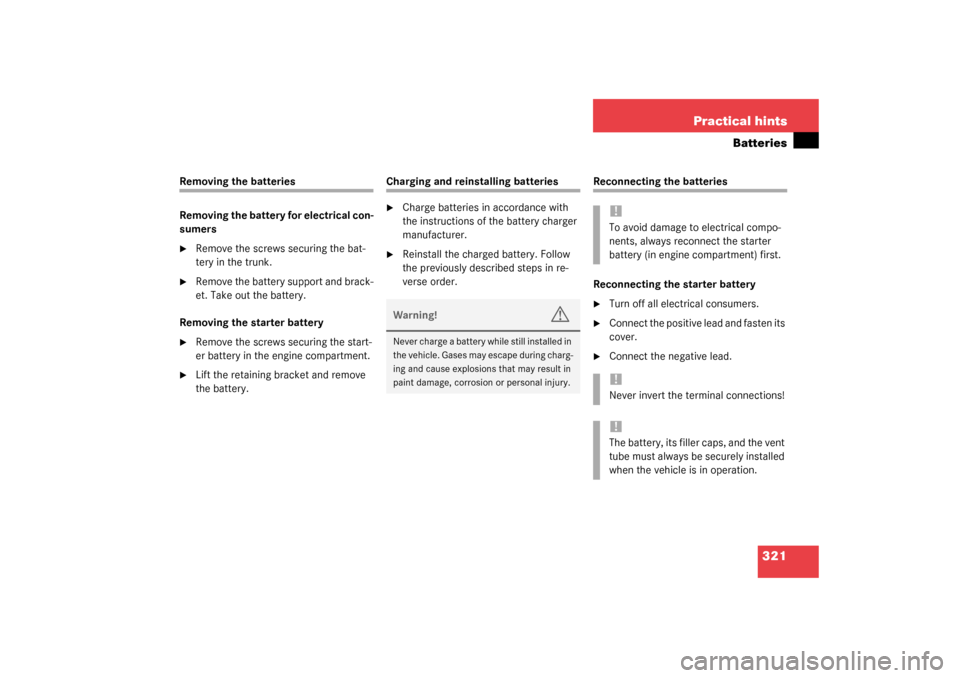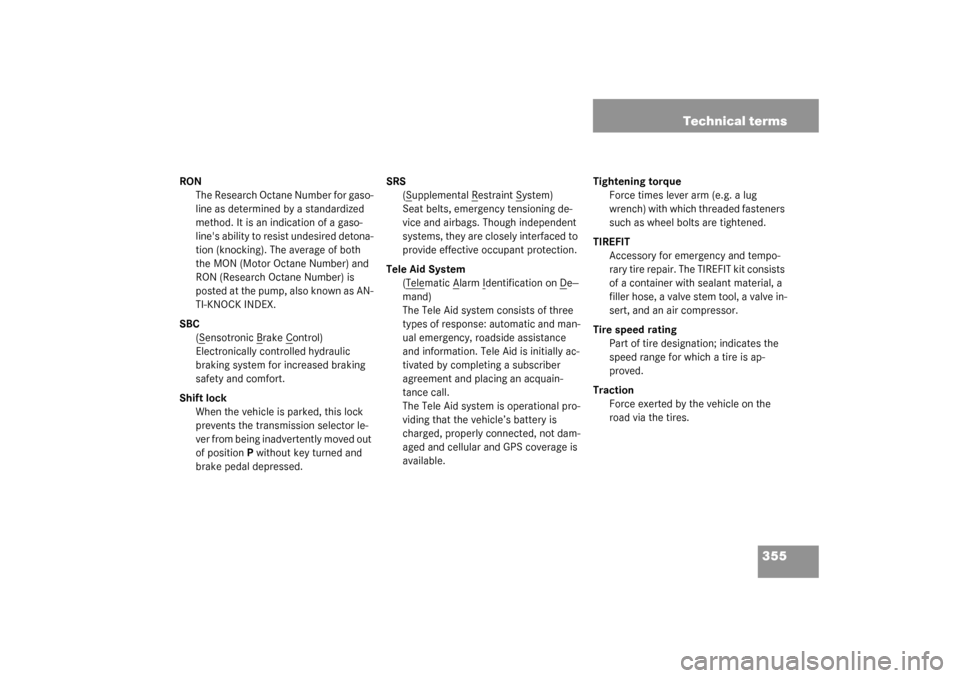Page 321 of 376

321 Practical hints
Batteries
Removing the batteries
Removing the battery for electrical con-
sumers�
Remove the screws securing the bat-
tery in the trunk.
�
Remove the battery support and brack-
et. Take out the battery.
Removing the starter battery
�
Remove the screws securing the start-
er battery in the engine compartment.
�
Lift the retaining bracket and remove
the battery.
Charging and reinstalling batteries�
Charge batteries in accordance with
the instructions of the battery charger
manufacturer.
�
Reinstall the charged battery. Follow
the previously described steps in re-
verse order.
Reconnecting the batteries
Reconnecting the starter battery�
Turn off all electrical consumers.
�
Connect the positive lead and fasten its
cover.
�
Connect the negative lead.
Warning!
G
Never charge a battery while still installed in
the vehicle. Gases may escape during charg-
ing and cause explosions that may result in
paint damage, corrosion or personal injury.
!To avoid damage to electrical compo-
nents, always reconnect the starter
battery (in engine compartment) first. !Never invert the terminal connections!!The battery, its filler caps, and the vent
tube must always be securely installed
when the vehicle is in operation.
Page 322 of 376
322 Practical hintsBatteriesReconnecting the battery for electrical
consumers�
Turn off all electrical consumers.
�
Connect the positive lead and fasten its
cover.
�
Connect the negative lead.
�
Reinstall the trunk floor.
�
Rehook trunk luggage cover into hold-
ers.
!Never invert the terminal connections!iThe following procedures must be car-
ried out following any interruption of
battery power (e.g. due to reconnec-
tion):�
Resynchronize the ESP
(�page 261).
�
Resynchronize side windows
(�page 158).
Page 323 of 376

323 Practical hints
Jump starting
Jump starting
If the starter battery is discharged, the en-
gine can be started with jumper cables and
the battery of another vehicle.Observe the following:
�
Jump starting should only be performed
when the engine and catalytic convert-
er are cold.
�
Do not start the engine if the battery is
frozen. Let the battery thaw out first.
�
Only use 12V batteries to jump start
your vehicle. Jump starting with a more
powerful battery could damage the ve-
hicle’s electrical system, which will not
be covered by the Mercedes-Benz
Limited Warranty.
�
Only use jumper cables with sufficient
cross section and insulated terminal
clamps.
Always make sure that the jumper ca-
bles are not on or near pulleys, fans, or
other parts that move when the engine
is started or running.
Warning!
G
Failure to follow these directions will cause
damage to the electronic components, and
can lead to a battery explosion and severe
injury or death.
Never lean over batteries while connecting
or jump starting, you might get injured.
Battery fluid contains sulfuric acid. Do not
allow this fluid to come in contact with eyes,
skin or clothing. In case it does, immediately
flush affected area with water, and seek
medical help if necessary.
A battery will also produce hydrogen gas,
which is flammable and very explosive. Keep
flames or sparks away from battery, avoid
improper connection of jumper cables,
smoking etc.
Read all instructions before proceeding.
!Jump starting may only be performed
on the battery installed in the engine
compartment.
Avoid repeated and lengthy starting at-
tempts.
Do not attempt to start the engine us-
ing a battery quick charge unit.
If the engine does not run after several
unsuccessful starting attempts, have it
checked at the nearest authorized
Mercedes-Benz Center.
Excessive unburned fuel generated by
repeated failed starting attempts may
damage the catalytic converter and
may present a fire risk.
Make sure the jumper cables do not
have loose or missing insulation.
Make sure the cable clamps do not
touch any other metal part while the
other end is still attached to a battery.
Page 324 of 376

324 Practical hintsJump startingThe starter battery is located in the engine
compartment.�
Make sure that the two vehicles do not
touch.
�
Turn off the engine.
�
Turn off all electrical consumers.
�
Apply parking brake.
�
Shift selector lever to positionP.1Negative terminal of charged battery
2Negative terminal of discharged
battery
3Positive terminal of discharged battery
4Positive terminal of charged battery
�
Remove the red cover from positive ter-
minal on both vehicles (
�page 319).
�
Connect the positive terminals 3 and 4
of the batteries with the jumper cables.
Start with the charged battery.
�
Start the engine of the vehicle with the
charged battery and run at idle speed.
�
Connect the negative terminals 1 and 2
of the batteries with the jumper cables.
Start with the charged battery.
�
Start the engine of the disabled vehi-
cle.
Now you can again turn on the electri-
cal consumers. Do not turn on the
lights under any circumstances.
�
Remove the jumper cables first from
the negative terminals 1 and 2 of the
batteries and then from the positive
terminals 3 and 4.
�
Have the battery checked at the near-
est Mercedes-Benz Center.
Warning!
G
Never lean over the battery while connect-
ing or jump starting.Warning!
G
Keep flames or sparks away from battery.
Do not smoke.
Observe all safety instructions and precau-
tions when handling automotive batteries
(�page 232).
iThe vehicle cannot be started via
tow-start.
Page 327 of 376

327 Practical hints
Towing the vehicle
Installing towing eye bolt
Front of vehicle
1Cover on right side of front bumper.
To remove cover:�
Press mark on cover in direction of ar-
row.
�
Lift cover off to reveal threaded hole for
towing eye bolt.
!When towing the vehicle with all wheels
on the ground, please note the follow-
ing:
With the automatic central locking acti-
vated and the key in starter switch
position2, or KEYLESS-GO* start/stop
button (if so equipped) in position2,
the vehicle doors lock if the left front
wheel as well as the right rear wheel
are turning at vehicle speeds of approx.
9mph (15km/h) or more.
To prevent the vehicle door locks from
locking, deactivate the automatic cen-
tral locking (
�page 91).
Towing of the vehicle should only be
done using the properly installed tow-
ing eye bolt. Never attach tow cable,
tow rope or tow rod to the vehicle chas-
sis, frame or suspension parts.
iThe selector lever will remain locked in
positionP and the key will not turn in
the starter switch if the battery is dis-
connected or discharged. See notes on
the battery (
�page 319) or on jump
starting (
�page 323).
Page 339 of 376
339 Technical data
Electrical system
Electrical system
Model
SL 500
SL 55 AMG
Generator (alternator)
14 V/150 A
14 V/180 A
Starter motor
12 V/1.7 kW
12 V/1.7 kW
BatteryStarter battery
12 V/35 Ah
12 V/35 Ah
Battery for electrical consumers
12 V/70 Ah
12 V/70 Ah
Spark plugs
Bosch F 8 DPER
NGK PFR 5 R-11
NGK IL FR 6 A
Electrode gap
0.039 in (1.0 mm)
0.039 in (1.0 mm)
Tightening torque
15 – 22 ft.lb (20 – 30 Nm)
15 – 22 ft.lb (20 – 30 Nm)
Page 355 of 376

355 Technical terms
RON
The Research Octane Number for gaso-
line as determined by a standardized
method. It is an indication of a gaso-
line's ability to resist undesired detona-
tion (knocking). The average of both
the MON (Motor Octane Number) and
RON (Research Octane Number) is
posted at the pump, also known as AN-
TI-KNOCK INDEX.
SBC
(S
ensotronic B
rake C
ontrol)
Electronically controlled hydraulic
braking system for increased braking
safety and comfort.
Shift lock
When the vehicle is parked, this lock
prevents the transmission selector le-
ver from being inadvertently moved out
of position P without key turned and
brake pedal depressed. SRS
(S
upplemental R
estraint S
ystem)
Seat belts, emergency tensioning de-
vice and airbags. Though independent
systems, they are closely interfaced to
provide effective occupant protection.
Tele Aid System
(Tele
matic A
larm I
dentification on D
e--
mand)
The Tele Aid system consists of three
types of response: automatic and man-
ual emergency, roadside assistance
and information. Tele Aid is initially ac-
tivated by completing a subscriber
agreement and placing an acquain-
tance call.
The Tele Aid system is operational pro-
viding that the vehicle’s battery is
charged, properly connected, not dam-
aged and cellular and GPS coverage is
available.Tightening torque
Force times lever arm (e.g. a lug
wrench) with which threaded fasteners
such as wheel bolts are tightened.
TIREFIT
Accessory for emergency and tempo-
rary tire repair. The TIREFIT kit consists
of a container with sealant material, a
filler hose, a valve stem tool, a valve in-
sert, and an air compressor.
Tire speed rating
Part of tire designation; indicates the
speed range for which a tire is ap-
proved.
Traction
Force exerted by the vehicle on the
road via the tires.
Page 362 of 376

362 IndexE
Easy-entry/exit 129
Interrupting movement 130
Message in display 271
Easy-Pack 198
Lowering manually 292
Electric air pump 316
Electrical consumer battery 232
Electrical outlet 199
Electronic Stability Program see ESP
Emergency call system*
Initiating emergency call 203
Requirements 201
Emergency engine shut-down 50
Emergency operation (Limp Home
Mode) 144
Emergency operations
Locking the vehicle 292
Lowering Easy-Pack 292
Unlocking interior storage
compartments 291
Unlocking the trunk 291
Unlocking the vehicle 290
Emission control 224
Emission control label 334Engine
Compartment 227
Starting with KEYLESS-GO* 40
Starting with the key 40
Turning off with KEYLESS-GO* 49
Turning off with the key 48
Engine number 352
Engine oil 228, 343
Adding 229
Additives 343
Checking level 228
Consumption 228
Filler neck 229
Messages in display 280
Engine oil level see Oil level 226
ESP 68, 70, 352
Messages in display 261
Switching off 71
Switching on 72
ESP control switch 24
ESP/ABS warning lamp 21
ETD (emergency tensioning device) 52,
60, 352F
Fahrenheit
Setting temperature units 122
Fastening the seat belts 37
Fine adjustment
Cruise control 170
Distronic* 177
First aid kit 288
Flat tire 302
Spare wheel 312
TIREFIT kit 302, 308
Flexible Service System (FSS) 241
Fog lamp, rear 104, 296
Replacing bulb 299
Fog lamps, front 104
Replacing bulbs 296
Front airbags 57
Front lamps 296
Replacing bulbs 298
FSS (Flexible Service System) 241, 352